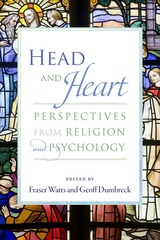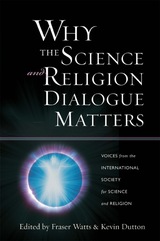2 books about Watts, Fraser

Head and Heart
Perspectives from Religion and Psychology
Fraser Watts
Templeton Press, 2013
Theologians and religious figures often draw a distinction between religion of the ‘”head” and religion of the “heart,” but few stop to ask what the terms “head” and “heart” actually denote. Many assume that this distinction has a scriptural basis, and yet many Biblical authors used the word “heart” as a synonym for “mind.” In fact, there isn’t a strict separation of the two concepts until the modern period, as in Pascal’s famous claim that “the heart has its reasons that reason can not know.” Since then, many other philosophers and theologians have made a similar distinction.
The fact that this distinction has been so persistent makes it an important area of study. Head and Heart: Perspectives from Religion and Psychology takes an inter-disciplinary approach, linking the thinking of theologians and philosophers with theory and research in present-day psychology. The tradition of using framing questions that have been developed in theology and philosophy can now be brought into dialogue with scientific approaches developed within cognitive psychology and neuroscience. Though these scientific approaches have not generally used the terms “head” and “heart,” they have arrived at a similar distinction in other ways. There is a notable convergence upon the realization that humans have two modes of cognition at their disposal that correspond to “head” and “heart.” The time is therefore ripe to bring the approaches of theology and science in to dialogue—an important dialogue that has been heretofore neglected.
Head and Heart draws on the unique expertise in relating theology and psychology of the University of Cambridge’s Psychology and Religion Research Group (PRRG). In addition to providing historical and theoretical perspectives, the contributors to this volume will also address practical issues arising from the group’s applied work in deradicalisation and religious education.
Contributors include Geoff Dumbreck, Nicholas J. S. Gibson, Malcolm Guite, Liz Gulliford, Russell Re Manning, Glendon L. Moriarty, Sally Myers, Sara Savage, Carissa A. Sharp, Fraser Watts, Harris Wiseman, and Bonnie Poon Zahl.
[more]

Why the Science and Religion Dialogue Matters
Voices from the International Society for Science and Religion
Fraser Watts
Templeton Press, 2006
Each world faith tradition has its own distinctive relationship with science, and the science-religion dialogue benefits from a greater awareness of what this relationship is. In this book, members of the International Society for Science and Religion (ISSR) offer international and multi-faith perspectives on how new discoveries in science are met with insights regarding spiritual realities.The essays reflect the conviction that “religion and science each proceed best when they’re pursued in dialogue with each other, and also that our fragmented and divided world would benefit more from a stronger dialogue between science and religion.”
In Part One, George F. R. Ellis, John C. Polkinghorne, and Holmes Rolston III, each a Templeton Prize winner, discuss their views on why the science and religion dialogue matters. They are joined in Part Two by distinguished theologians Fraser Watts and Philip Clayton, who place the dialogue in an international context; John Polkinghorne’s inaugural address to the ISSR in 2002 is also included. In Part Three, five members of the ISSR look at the distinctive relationships of their faiths to science:
•Carl Feit on Judaism•Munawar Anees on Islam
•B.V. Subbarayappa on Hinduism
•Trinh Xuan Thuan on Buddhism
•Heup Young Kim on Asian Christianity
George Ellis, the recently elected second president of ISSR, summarizes the contributions of his colleagues. Ronald Cole-Turner then concludes the book with a discussion of the future of the science and religion dialogue.
[more]
READERS
Browse our collection.
PUBLISHERS
See BiblioVault's publisher services.
STUDENT SERVICES
Files for college accessibility offices.
UChicago Accessibility Resources
home | accessibility | search | about | contact us
BiblioVault ® 2001 - 2024
The University of Chicago Press









